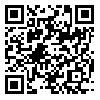جلد 9، شماره 4 - ( 7-1399 )
جلد 9 شماره 4 صفحات 46-40 |
برگشت به فهرست نسخه ها
Download citation:
BibTeX | RIS | EndNote | Medlars | ProCite | Reference Manager | RefWorks
Send citation to:



BibTeX | RIS | EndNote | Medlars | ProCite | Reference Manager | RefWorks
Send citation to:
Atarbashi-Moghadam S, Rabani S, Sijanivandi S. Research Paper: Connective Tissue Lesions of the Oral Cavity: a Survey of 783 Cases in Major Oral Pathology
Center in Iran. Journal title 2020; 9 (4) :40-46
URL: http://3dj.gums.ac.ir/article-1-408-fa.html
URL: http://3dj.gums.ac.ir/article-1-408-fa.html
Research Paper: Connective Tissue Lesions of the Oral Cavity: a Survey of 783 Cases in Major Oral Pathology
Center in Iran. عنوان نشریه. 1399; 9 (4) :40-46
چکیده: (2070 مشاهده)
Introduction: Oral mesenchymal lesions account for a large and diverse range from reactive to tumoral lesions. Many studies have been conducted on the frequency of reactive lesions in different countries, though few studies are available on the frequency of soft tissue neoplasms. The present study aimed to investigate the frequency of these lesions in a major oral pathology center in Iran
Materials and Methods:This retrospective study was carried out on the documents of Oral Pathology Department, Shahid Beheshti University of Medical Sciences, Iran. Files with a diagnosis of oral mesenchymal lesions were selected. The lesions were categorized into “reactive” and “neoplastic” groups. Chi-square, Kruskal-Wallis, Fisher exact, and T-test were used for statistical analysis.
Results: During the 11 years, 783 patients had oral mesenchymal lesions (22.24%). From these cases, 82.12 % had reactive lesions and 17.75% showed neoplastic lesions. The majority of cases were in their 6th decade of life and the female to male ratio was 1.49:1. Gingiva was the most common site of involvement (45%). 98.46% of the neoplastic lesions were benign and 1.4% were malignant. The most common reactive lesion was irritation fibroma, epulis fissuratum, and pyogenic granuloma respectively. Giant cell fibroma and lipoma were the most common neoplasm.
Conclusion:This study provides a large set of demographic and histopathological data on reactive and neoplastic lesions of the oral connective tissue lesions and showed the rate of reactive lesions was approximately 4.6 times higher than neoplastic lesions. Benign mesenchymal
lesions were also 70 times more common than sarcomas.
Materials and Methods:This retrospective study was carried out on the documents of Oral Pathology Department, Shahid Beheshti University of Medical Sciences, Iran. Files with a diagnosis of oral mesenchymal lesions were selected. The lesions were categorized into “reactive” and “neoplastic” groups. Chi-square, Kruskal-Wallis, Fisher exact, and T-test were used for statistical analysis.
Results: During the 11 years, 783 patients had oral mesenchymal lesions (22.24%). From these cases, 82.12 % had reactive lesions and 17.75% showed neoplastic lesions. The majority of cases were in their 6th decade of life and the female to male ratio was 1.49:1. Gingiva was the most common site of involvement (45%). 98.46% of the neoplastic lesions were benign and 1.4% were malignant. The most common reactive lesion was irritation fibroma, epulis fissuratum, and pyogenic granuloma respectively. Giant cell fibroma and lipoma were the most common neoplasm.
Conclusion:This study provides a large set of demographic and histopathological data on reactive and neoplastic lesions of the oral connective tissue lesions and showed the rate of reactive lesions was approximately 4.6 times higher than neoplastic lesions. Benign mesenchymal
lesions were also 70 times more common than sarcomas.
نوع مطالعه: پژوهشي |
موضوع مقاله:
Pathology
دریافت: 1399/7/14 | پذیرش: 1399/9/25 | انتشار: 1399/9/25
دریافت: 1399/7/14 | پذیرش: 1399/9/25 | انتشار: 1399/9/25
| بازنشر اطلاعات | |
 | این مقاله تحت شرایط Creative Commons Attribution-NonCommercial 4.0 International License قابل بازنشر است. |


